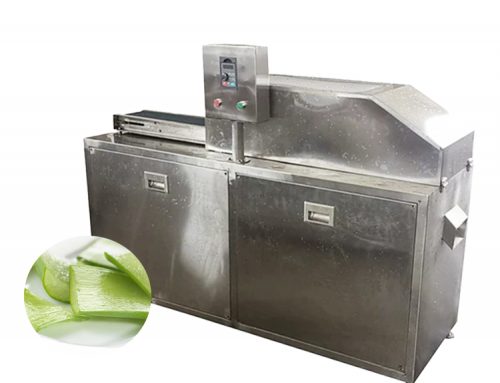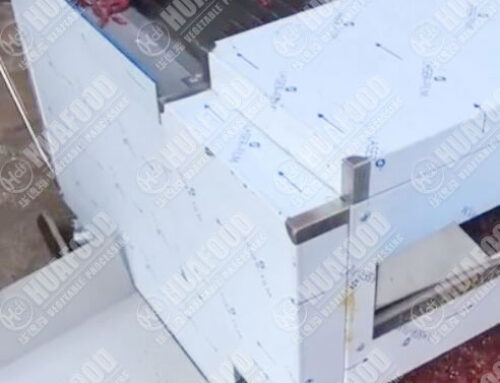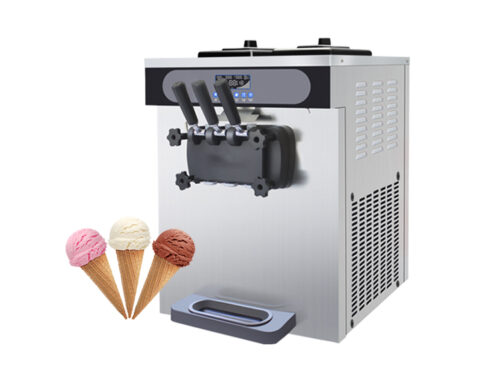商用芒果脱皮机价格
When considering the 芒果剥皮机 price, one should know that for industrial-scale machines tailored to processing large volumes of mangoes, the cost typically ranges from several thousands to tens of thousands of US dollars, depending on capacity, automation, and configuration. In industrial fruit-processing plants, a mango peeling machine may start in the low thousands for simpler models and escalate into the tens of thousands of dollars for fully automated, multi‐head, high-capacity versions.
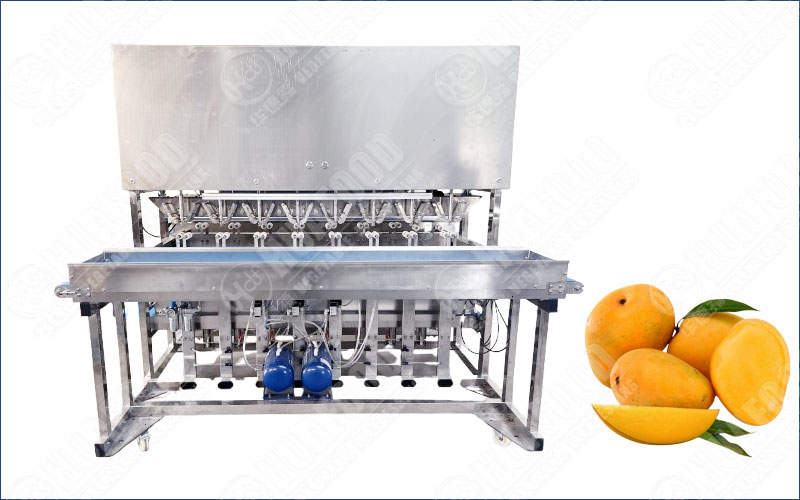
The main factors that drive the mango peeling machine price include machine capacity (throughput), the degree of automation and control (PLC, sensors, adaptive features), build materials (stainless steel grade, food-safe finish), multi‐function integration (脱皮 + pitting + 切片), brand/customization. In this blog we’ll examine an industrial mango peeling machine in depth—focusing on how the characteristics of the mango fruit itself (尺寸, 形状, skin/pulp characteristics) tie into machine design—and then break down how each of those price-influencing factors plays out.
Understanding the fruit: mango and its key features
The mango is a tropical fruit with a tough outer skin that can vary in thickness, colour, and firmness depending on variety and ripeness. The pulp is soft and juicy, often delicate, and must be preserved as intact as possible in industrial processing to maintain yield and product quality. Handling mangoes presents particular challenges:
The shape of mangoes is irregular — many have an oblong oval shape, sometimes with a bulge at one end, a stone (pit) in the centre that may vary in size and position.
Skin thickness and adherence: some varieties adhere tightly to pulp, some less so; the peel must be removed without significant pulp loss.
Pulp softness in ripe fruit: if the peeling method is too aggressive, the pulp may be bruised or damaged.
Volume demands: in many processing lines (for canned mango, frozen mango cubes, mango puree) high throughput is required, so the peeling machine must cope with large quantities while maintaining consistency.
Given these characteristics, a robust industrial mango peeling machine must be designed to: accommodate variable sizes of mango, fix them securely without damaging the pulp, peel the skin with precision and minimal waste, sometimes remove the stone or halve the fruit, and deliver uniform output suitable for further processing.
Industrial mango peeling machine – key configuration and professional specification
When we refer to a “mango peeling machine” in an industrial contexte (例如。, processing factory for mango cubes, dried mango slices or frozen mango blocks), the equipment typically has the following professional features:
Heavy-duty stainless steel construction (food-grade materials, 例如。, 304 SS) for hygiene, 耐用性, 耐腐蚀性.
PLC (programmable logic controller) or equivalent control system for automated operation, 可调参数 (peel thickness, fruit size).
Adjustable peeling knives/blades or grinding wheels that follow the fruit contour, ensuring the skin is removed while minimizing pulp loss; many machines allow the peel thickness to be set, 例如。, 1.5 mm-2.5 mm.
Capacity configured per throughput: for example a machine may process 15-30 mangoes per minute or more.
Multi-head systems (例如。, 8-head, 16-head) to increase simultaneous processing and throughput.
Additional functions: some machines integrate peeling + destoning (pit removal) + halving/slicing in one cycle, which can reduce downstream labour and equipment.
Wide adaptability: able to handle different mango sizes (diameter, height) and sometimes other fruits/vegetables for versatility.
Safety features, hygiene design (易于清洁), minimized waste (peel separated from pulp), operator-friendly interface.
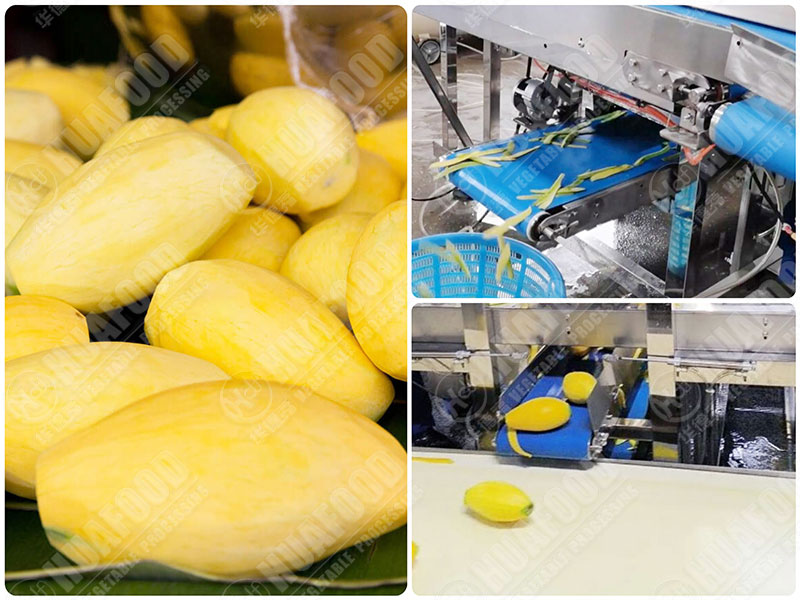
Influencing Mango Peeling Machine Price Factors
Below we break down how each of the major factors influences the mango peeling machine price, aligning each to the equipment’s specification as above.
1. Throughput / 容量
The higher the throughput (how many mangoes processed per minute or hour), the more complex and robust the machine needs to be. 例如, a machine designed for 1000 kg/h or multi-head 16-head systems that process multiple mangoes at once cost more due to heavier duty motors, more complex feeding/handling systems, increased size and control components.
Higher capacity impacts price because of increased material, labour engineering, and control system complexity.
2. Level of automation & multi‐function integration
A basic mango peeling machine may only remove the skin. More advanced machines integrate destoning (pit removal), halving, 切片, even downstream conveyors and waste separation. 例如, the machine from Huafood that peels and destones up to 20 mangoes per minute demonstrates this level of integration.
Multi‐function machines reduce labour and subsequent equipment but cost more upfront — the mango peeling machine price rises accordingly.
3. 材料 & build quality
Catering to industrial and food-processing standards, machines made of high grade stainless steel, heavy frames, 卫生设计 (易于清洁, minimal contamination risk) cost more. The mango peeling machine specification emphasises 304 不锈钢, food-contact parts comply with FDA or equivalent.
A machine built for high-volume use in a processing plant will cost more than a smaller workshop model.
4. Adjustable features / 灵活性
Because mangoes vary in size, ripeness, 形状, and processing requirements vary (cubes, 切片, puree), machines with adjustable peel thickness, size adaptors, multiple heads, interchangeable modules cost more. 例子: peel thickness adjustable from ~1.5 mm to ~3 mm.
The ability to handle different fruit diameters/heights adds to design and manufacturing cost — thus increasing mango peeling machine price.
5. 定制化 & brand/service level
If the machine is customized (tailored for your mango variety, local voltage/frequency, your layout, extra conveyors or waste separation) or from a premium brand with strong after-sales, 保修单, the price is higher. Many suppliers of mango peeling machines emphasize customization support and lifetime technical service.
So the mango peeling machine price you quote should reflect whether it is standard or custom.
Why focusing on the mango’s specific requirements matters for pricing
Because mangoes are more challenging to process than many simpler fruits (例如。, peeled apples or potatoes), the machine’s design must account for:
Variable stone size and position: many mango varieties have large or irregularly placed stones, so the peeling machine must ensure the skin removal avoids the stone area while preserving pulp. The destoning-peeling machines show how this adds complexity.
Soft pulp integrity: Especially for ripe mangoes, pulp may be delicate; the machine must hold fruit securely without bruising it. This means more refined feeding, more advanced blade controls, sensors.
Skin adhesion and variety differences: Some mangoes have thicker skin, some more fibrous peel, some different sizes—requiring adjustable machine parameters (size adaptors, speed, blade configuration).
Downstream processing needs: If the peeled mango is destined for cubes, 切片, frozen blocks, or puree, the peeling machine often must deliver a specific specification (minimal skin residue, 均匀的形状) — meaning better quality machine and thus higher price.
Practical example: what you might expect & how to compare
When you compare mango peeling machines, here are practical metrics and questions to ask to understand price differentiation:
容量 (kg/h or pcs/min): If one machine does 800 kg/hr and another 3000 公斤/小时, likely the higher capacity unit costs more. 例如, a model reported 3.0 ton per hour capacity.
Number of heads / working stations: Multi-head machines (例如。, 16 heads) allow parallel processing. The example “Industrial 16‐head mango peeling machine” shows this.
Peel thickness adjustment / size adaptability: Machines that allow adjustable peeling thickness from ~1.5 mm to 3 毫米, and accommodate diameters say 40-100 毫米, height 80-150 毫米, cost more.
Integrated functions: If peeling + destoning + halving/slicing are integrated, you are paying more. The Huafood machine that does
脱皮, destoning and halving in one cycle is an example.
材料 / build quality: A machine made of 304 不锈钢, food-safe parts, with automatic control, will cost more than a simpler frame.
Total cost of ownership: Consider energy consumption (motor size, compressor etc), 维护 (spare parts), labour savings. Often a higher initial cost machine may pay back faster through higher efficiency and lower waste.
Summary
总之, when considering your next purchase and quoting for a mango peeling machine, you should appreciate that:
The mango peeling machine price ranges from thousands to tens of thousands of USD in the industrial arena.
The key cost drivers are capacity/throughput, machine automation and functionality, build material and hygiene standard, adjustability/flexibility, brand/customization, and total landed installation cost.
Because mango fruit present specific challenges (irregular shape, varying size, delicate pulp, stone removal), a dedicated industrial machine configured for mangoes—and possibly integrated with destoning/slicing—will command a premium compared to generic fruit peeling machines.
By carefully comparing specifications (公斤/小时, heads, peel thickness adjustability, 材料, included functions) you can evaluate whether a given machine’s price is justified and aligned with your operational needs.
If you are ready to evaluate a mango-processing line or require a detailed quote for an industrial mango peeling machine tailored to your output, variety of mango, layout and budget, please leave your enquiry with us online now. We can provide you with full specifications, options, and a competitive quote to support your mango-processing business.

700-500-6-500x383.jpg)
